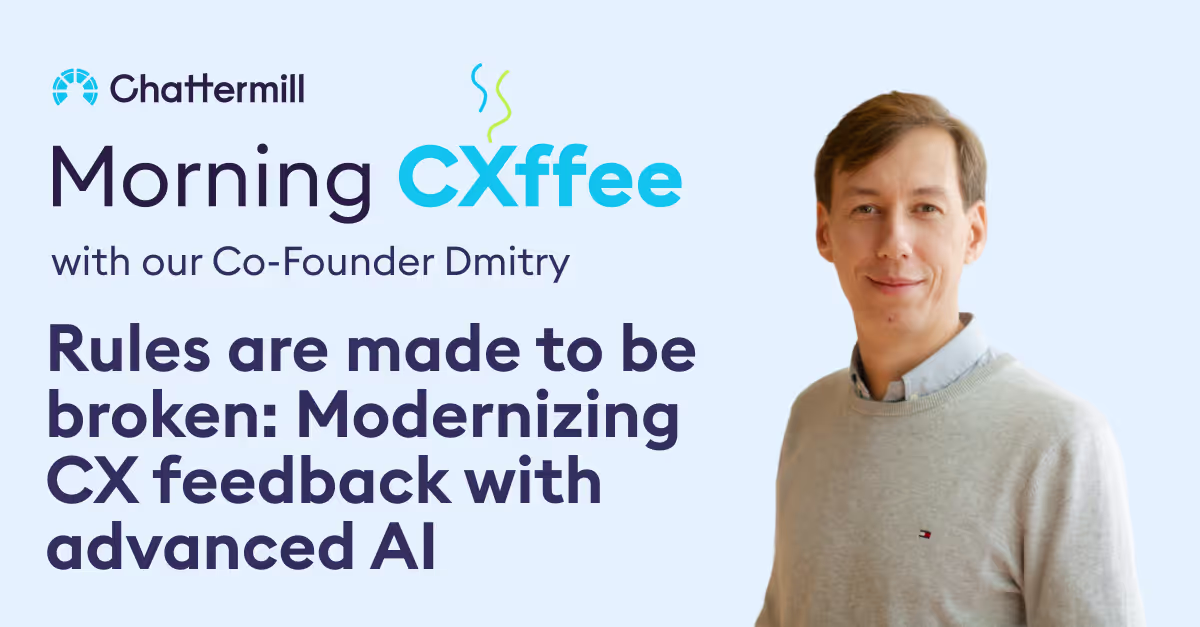As someone who has worked with AI since 2009, I've seen firsthand the difficulties companies face when adopting technology at the peak of impossible expectations - and there's no sign of this slowing down. In fact, Gartner predicts that by 2025, 80% of customer service and support organisations will be applying generative AI technology in some form to improve agent productivity and customer experience (CX).
There are a lot of options out there and it’s hard to know what’s right for you. Below I put together a list of all the things CEOs and business leaders should consider when choosing the technology that will support their Customer Experience programmes.
CX Intelligence: A Complex Pursuit
Customer Experience (CX) is now recognized as a key driver of growth for businesses in 2024. McKinsey analysis shows that companies who are leaders in customer experience grow at twice the rate as their competitors. The benefits of putting your customers’ experience first are clear: increased awareness, improved acquisition conversion, stronger retention and loyalty, and a stellar brand reputation that drives cross-sell and upsell opportunities.

Despite these benefits, underinvestment in CX persists. One reason is that few CX programs successfully connect the dots between customer experience insights and strategic business outcomes.
From Whac-A-Mole to Multiple Sentiment
As my colleague Dmitry recently wrote, many CX initiatives take a finder-fixer approach. If customer experience was simply about neutralizing negative issues, we’d all just monitor for tactical problems and try to solve them. But neutrality only brings you back to basic expectations, and CX, the kind that drives business growth, isn't just about meeting expectations; it’s about exceeding them. Identifying what drives positivity from customer feedback is crucial.
Example: When a customer raves about the exceptional service at a hotel, it provides insight into what aspects of service are most valued and can be leveraged for strategic improvement. Looking at positives means you can double down on what you’re already doing well.
Going Beyond Tactical to Deliver Strategic and Precision Insights
To unlock the power of CX Intelligence, it’s essential to connect granular, actionable feedback with their overarching customer experience goals. By understanding how tactical issues contribute to strategic outcomes, companies have a continuum that shows the way to connect daily improvements with broader business objectives.
This approach fosters authentic positive word-of-mouth growth and informs the CEO about what to prioritize. The strategic-to-tactical continuum, combined with the need to identify both positive delighters and negative detractors, creates a complex problem. Advanced AI is required to read and truly understand customer stories at scale, maintaining human-level context and understanding while never missing a single nuance.
Example: A retail brand may discover that quick response times and personalized recommendations are key drivers of customer satisfaction. Aligning these insights with strategic goals can help prioritize investments in customer support technology and personalized marketing strategies.
Supporting hybrid customer experiences
Brands like Starbucks, Disney, and Nike offer multi-sensory experiences that blend digital and physical interactions. The huge and rapidly evolving vocabulary required to truly understand customer sentiment and meaning at scale requires fit for purpose AI.These brands need to capture the full spectrum of customer feedback, from the smell of coffee to the thrill of a theme park ride, and the fit of a new pair of shoes.
One way I think about this is within Gregory Bateson’s claim that “Without context, words and actions have no meaning at all.” This connection between context and meaning is about the nuances and richness of language, but it’s also about a continuum from no context to deep understanding across many contexts.
Example: Nike can use customer feedback from both online reviews and in-store experiences to understand how their products perform in real-world conditions and to improve product design and customer service strategies.
The Limitations of Rules-Based Solutions
Rules-based solutions have been around for a long time and they are appealing because they are easy to understand. You build keyword lexicons to predict probable words in comments that mention tactical issues. This approach is straightforward and transparent but has limitations:
- Tactical Focus: Rules-based systems are excellent for immediate problem-solving but lack the strategic insight needed for long-term growth.
- Contextual Understanding: These systems often miss the broader context of feedback, failing to capture the depth of customer sentiment and the nuanced drivers behind it.
- Adaptability Issues: As customer language evolves, rules-based systems require constant updates, making them less flexible and scalable.
Example: A keyword-based approach might identify the term "slow service" frequently but fail to understand the context that the slow service was during peak hours, which changes the strategic approach to resolving the issue.
Fit-for-Purpose AI for CX
Technology that straddles the strategic-to-tactical divide and maintains precision, recall, and context at both ends of the spectrum is necessary. Under the broad banner of CX, many tools act as point solutions to track and find negative drivers in specific teams and use cases. These are often a good fit for digital products with limited surface areas, such as apps that need to perform predictably. However, they also need to capture positive drivers, which are often inferred or nuanced, and handle context when moving from tactical issues to strategic concepts like speed and convenience.
Example: An app-based service like Uber must not only address technical issues (e.g., app crashes) but also understand broader concepts like user convenience and driver reliability, which are crucial for strategic decision-making.
Modern AI: The Future of CX
Advanced AI systems, like Chattermill’s Lyra AI, offer a stark contrast. They process unstructured data at scale, retaining human-level understanding and context. This allows businesses to capture comprehensive insights from diverse sources such as surveys, social media, review sites, support tickets, and chatbots. Modern AI links tactical details with strategic goals, enabling prioritized decision-making aligned with business objectives.
Example: HelloFresh uses advanced AI to analyze customer feedback from recipe ratings, support tickets, and social media mentions to improve their meal kit offerings and enhance the overall customer experience.
Comprehensive Platforms vs. Point Solutions
Comprehensive platforms that balance both strategic and tactical insights support more informed decision-making at the highest levels. They provide a unified view of customer feedback, capturing both positive and negative drivers. In contrast, point solutions are often disjointed, addressing specific needs within teams but lacking strategic cohesion.
Example: A financial services company might use a comprehensive platform to integrate feedback from customer service interactions, online reviews, and social media to improve both their mobile app performance and in-branch customer service.
Conclusion
By choosing a comprehensive platform that balances strategic and tactical insights, CEOs and CX leaders can drive more informed decision-making, ensuring sustained growth and a competitive advantage. When it comes to modernizing your CX strategy and actually turning it into a business growth driver, I firmly believe that you can break the rules and opt for something that is actually fit for CX. Embrace advanced AI to drive strategic growth, improve customer satisfaction, and ensure sustained competitive advantage.
Key Takeaways for CEOs and CX Leaders:
- Legacy Technology Limitations: Rule-based systems struggle with unstructured feedback, limiting insight depth.
- Unstructured Data Value: Advanced AI offers richer, more authentic customer insights.
- Strategic Alignment: Modern AI links tactical details with strategic goals.
- Scalability and Adaptability: Comprehensive platforms handle evolving customer language and diverse feedback sources.
- Holistic View: Advanced AI captures both positive and negative drivers, providing a complete picture of customer experience.
















